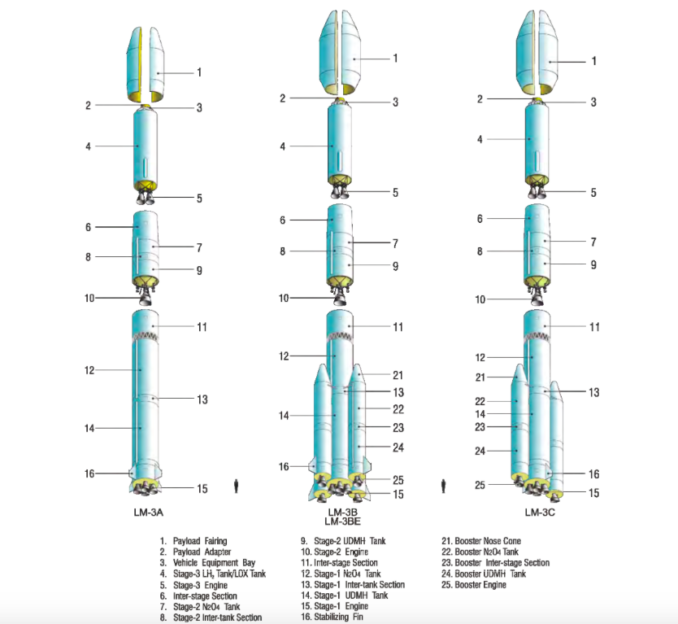Launch Window/Lift Off Time | February 05, 2021 – 15:29 UTC | 23:29 BJT |
|---|---|
Mission Name | Tianhui-2-3, the third Tianhui-2 Earth observation satellite |
Launch Provider | China Great Wall Industry Corporation (CGWIC) |
Customer | Chinese Ministry of Defense |
Rocket | Long March 3B/E |
Launch Location | Xichang Satellite Launch Center, China |
Payload mass | Unknown, up to 7,100 kg (15,700 lb) to Sun-synchronous orbit |
Where is the satellite going? | 490 x 505 km sun-synchronous orbit |
Will they be attempting to recover the first stage? | No, the boosters of the rocket are not recoverable |
Where will the first stage land? | It will crash back over land in North-West China |
Will they be attempting to recover the fairings? | No, the fairings are not recoverable |
Are these fairings new? | Yes |
How’s the weather looking? | No information available |
This will be the: | – 73rd flight of a Long March 3B (any variant) – 4th Chinese launch in 2021 – 2nd launch of a Long March 3B/E variant in 2021 – 11th orbital launch attempt of 2021 |
Where to watch | Official livestream (if available) |
What’s all this mean?
The China Great Wall Industry Corporation will launch the Tianhui-2-3 satellite atop a Long March 3B/E. It is an Earth observation satellite that will be deployed into a 490 km by 505 km sun-synchronous orbit.
Tianhui Satellites
The Tianhui (or “sky drawing”) constellation of satellites are Earth observation satellites built by Dong Feng Hong and operated by the People’s Liberation Army, which is part of the Chinese ministry of defense. The Tianhui-2-3 satellite will monitor the ground in both the visible and infrared spectrum, with two cameras. With these cameras the satellite has a resolution of under 5 meters and a field of view of roughly 25°. The satellite will also survey human activities.
Due to the nature of the payload, very little is known about the actual satellite. However, it is known that the satellite is equipped with two solar arrays and the two aforementioned cameras.
What is the Long March 3B?
Despite the Chinese rockets having different heritages, most of China’s orbital launch vehicles use the “Long March” (Chang Zheng) naming scheme. The Long March 3B is a three stage rocket, with an optional fourth stage. The rocket has four liquid-fueled side boosters, and first launched in 1996.
The Long March 3B/E, the enhanced version of the Long March 3B, was first launched in 2007 and has greater Geostationary Transfer Orbit (GTO) payload capacity. The enhanced 3B/E’s have a larger first stage and larger side boosters, compared to the original Long March 3B. As a result, its payload capacity to GTO was increased from 5,100 kg to 5,500 kg.
The Long March 3B series features the following sections or stages:
- Side boosters
- First (center) stage (ignited at launch)
- Second stage
- Third stage
- Optional fourth stage
Side boosters
There are 4 side boosters that each use one YF-25 engine, which is powered by Unsymmetrical Di-Methyl Hydrazine (UDMH) and Nitrogen Tetroxide (N2O4).
The regular Long March 3B’s side boosters are 15.33 m (50.3 ft) long, but on the enhanced version they are 16.1 m (52.3 ft) long, producing 740 kN of thrust. The YF-25 engine has a specific impulse (ISP) of 260 seconds, and burns for 140 seconds on the 3B/E variant.
First (center) stage
The first stage has 4 YF-21C engines, which also use UDMH / N2O4 for propellant. The first stage has an ISP of 260 seconds and produces 2,960 kN of thrust. The LM-3B first stage is 23.27 m (76.35 ft) tall, but the 3B/E is 24.76 m (81.23 ft) tall.

Second Stage
The second stage is powered by a single YF-22E engine. However, attitude control is provided by a single YF-23 Vernier engine, and combined, these engines are known as a YF-24 module. The engine runs on UDMH and N2O4 and produces 742 kN of thrust. The second stage is 12.9 m (42.3 ft) tall and burns for 185 seconds.

Third stage
The third stage is 12.4 m (40.7 ft) long and is powered by 2 YF-75 engines. Unlike the other stages, this stage is powered by liquid hydrogen (LH2) and liquid oxygen (LOX).
The third stage will burn after the second stage is jettisoned, in order to continue to raise the orbital apogee (maximum altitude). Once the target apogee has been achieved, it shuts down. The vehicle will then coast to apogee, where the stage relights and burns to raise the perigee (lowest altitude) of the orbit.
Optional fourth stage
The fourth stage runs on UDMH / N2O4, and has a singular YF-50D engine.





